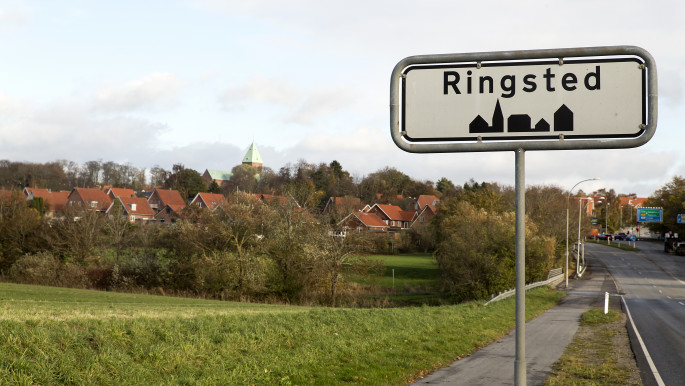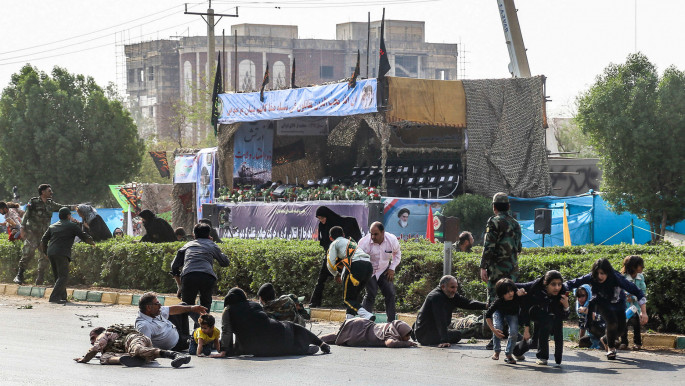Iranian 'Traitors', Saudi 'Spies': Is Denmark the latest frontier of Tehran and Riyadh’s Cold War?
Though intriguing in and of itself, the incident is only the latest episode in a dramatic chain of events involving Iranian dissidents in Denmark over the past year and a half, including attempted assassinations, large-scale manhunts as well as international espionage.
The latest flare-up sees many across the world wondering, is Denmark being swept into the high-stakes international proxy war between two Middle Eastern powers?
Although yet to be publicly identified, the three arrested are thought to be senior members of the Arab Struggle Movement for the Liberation of Ahvaz (ASMLA), a group of Arab Iranians living in exile in Europe and campaigning for the independence of Iran's Khuzestan province, an oil-rich majority-Arab area in the country's southeast.
ASMLA: Small-town Saudi spies?
The trio, who run the organisation out of the sleepy Danish town of Ringsted, pleaded not guilty to the charges, which allege that they had spied for an unnamed Saudi intelligence service over a six year period starting from 2012.
State intelligence agencies, such as those of Riyadh, often use third party companies for overseas spy recruitment and operations to obscure their paper trail.
 |
|
| The small town of Ringsted was the base of the spying operations [Getty] |
Alongside their media activity and activism, ASMLA has allegedly been spying on European companies and individuals, speculated to include those linked to the Iranian embassy and Iranian-funded mosques and cultural centres.
The leader of Denmark's ASMLA faction, who is thought to have been arrested, lives under Danish police protection due to the threat of Iranian intelligence service attacks.
However, there has been resounding support across the spectrum of Danish politics to take a hard line against the group's activities, for potentially inviting a violent cycle of tit-for-tat attacks by foreign powers.
Having been indicted, the trio now face potential life sentences, which average 16 years in Denmark.
Denmark's 'Skripal moment'?
Last week's happenings seem all the more serious because they tie into a series of unusually dramatic events that have hit the mostly scandal-free nation.
In September 2018, swathes of Denmark's Zealand island were put under lockdown as police searched for a Swedish-registered car thought to be carrying three people involved in a "serious crime".
Details of what actually happened took weeks to come to light, with Denmark's Security and Intelligence Service (PET) finally revealing to have been hunting Iranian operatives thought to be planning an assassination against ASMLA activists in Denmark.
Israel's intelligence agency Mossad were rumoured to have helped the Danish operation to locate the would-be assassins, indicating the international scale of the events.
Twitter Post
|
Despite the car they were searching for turning out not be connected to the assassination plot, PET levelled serious accusations at Tehran for plotting attacks on its soil.
Around the same time, a dual Iranian-Norwegian national was arrested in Sweden and extradited to Denmark, after having been found photographing the house of Habib Jabor, the ASMLA leader in Denmark.
Politician Nick Hækkerup compared the plot on Danish TV to Russia's attempted poisoning of Russian double agent Sergei Skripal and his daughter in the British town of Salisbury the previous March.
The Islamic republic – whose ambassador was subsequently ejected from Denmark after the alleged assassination attempt – issued strong denials of the Danish charges, calling them "biased" and part of a "conspiracy" to harm relations between Iran and Europe.
Denmark's ASMLA assassination: Avenging Ahvaz?
The attempted assassination was reportedly to avenge a shooting at a military parade in Ahvaz, in Iran's Khuzestan province several days previously, which killed 29, including 12 Revolutionary Guards and many civilians. In a confusing aftermath, the ASMLA claimed responsibility for the attack but retracted the claim soon after. The Islamic State group also claimed the attack, despite it lacking any of the jihadist group's usual hallmarks.
The ASMLA in Denmark publicly announced their support for the Khuzestan attack, prompting "huge criticism" among the Danish public, Fannie Agerschou-Madsen, a Gulf specialist at Copenhagen University, told The New Arab, which caused them to "withdraw [their] apparent support and [say] they were misunderstood."
Following the attack, Iran accused Denmark, the Netherlands and Britain of sheltering members of militant opposition groups, pointing the finger at ASMLA.
 |
Evidence of the relationship between a Saudi intelligence service and the now indicted ASMLA members accidentally emerged as the Danish authorities were investigating [their] computers |  |
Iran led a characteristically heavy handed crackdown on the province, arresting hundreds of Arab Iranians, among which human rights groups claim more than 20 were executed in secret without trial.
Denmark's PET launched an ensuing investigation into the ASMLA's senior members around whether they had publicly condoned acts of terrorism or committed other criminal offences.
This probe led to the incidental discovery of the same three men's alleged espionage.
Ali Alfoneh, an Iranian-Danish scholar based at Washington DC's Arab Gulf States Institute, told The New Arab: "Evidence of the relationship between a Saudi intelligence service and the now indicted ASMLA members accidentally emerged as the Danish authorities were investigating [their] computers," for signs of Iranian government hacking.
Zero tolerance response
In February 2020, almost 18 months after the previous flare-up, Danish authorities issued harsh warnings to Iran and Saudi Arabia for their alleged infringements of Danish sovereignty.
 |
|
|
Read also: What the Ahvaz attack means for Iran's |
"We are talking about a very complex case where two countries – Iran and Saudi Arabia – are bringing internal strife into this country," Danish security service chief Finn Borch Andersen said on 3 February.
"It is the view of the PET that the three people, in the period from 2012 to 2018, have been spying for a Saudi Arabian intelligence service," PET chief Finn Borch Andersen told reporters.
Jeppe Kofod, Denmark's foreign minister, called the alleged espionage a "serious and completely unacceptable case," summoning an emergency meeting of the foreign policy committee.
Kofod also summoned the Saudi ambassador for a meeting in which the Iranian envoy was also reportedly present.
ASMLA: Threat or victim?
The series of events have left many wondering who really are the ASMLA, and whether they should be counted as a dangerous proxy working for Saudi Arabia, or as victims of Iranian regime persecution.
Twitter Post
|
Formed in 1999, the group consists of a media arm, including a TV channel and a news website, documenting the purported persecution of Arabs in Iran and campaigning for independence.
Since 2015, the group has been based jointly in Denmark and the Netherlands. Last week, another Iranian was arrested in the Dutch city of Delft for allegedly plotting a terror attack in Iran, and for being a member of a terrorist organisation.
ASMLA's founder, Ahmad Mola Nissi, was shot dead in November 2017 outside his home in the Netherlands.
These incidents, many of which have been linked to Iranian intelligence services, show the danger of being vociferous opponents of repressive regimes wherever in the world they may have sought refuge, according to observers.
"As dissidents in exile get organised and effective in drawing attention inside the country, the Islamic Republic's authorities are working hard to undermine their legitimacy and even eliminate them," Roya Boroumand, the executive Director and co-founder of the Abdorrahman Boroumand Foundation, told The New Arab.
Moreover, the Danish faction is arguably attempting to rebrand as a political and intellectual force. According to Agerschou-Madsen, the group is "trying to gather support for their political cause by advocacy work and by influencing both international politicians and scholars," including organising and financing academic conferences at universities across Europe.
 |
As dissidents in exile get organised and effective in drawing attention inside the country, the Islamic Republic's authorities are working hard to undermine their legitimacy and even eliminate them |  |
But the group seems to also retain a military arm that has claimed responsability for a series of deadly bombings in Khuzestan since its founding – for which Iran classifies the group as a terrorist organisation.
And rather than being a strategic European move, their headquarters ended up in Denmark by accident, it being just one of many European countries offering asylum to Iranians fleeing war in the 1980s, Alfoneh points out.
Saudi Arabia: The enemy of my enemy is my friend
Saudi Arabia has for many decades sought cosy relations with the Iranian government's enemies.
Twitter Post
|
It is evident in the amount of coverage given to Ahwazi separatism in regime-controlled Saudi media it is a cause célèbre.
Maysam Behravesh, a Gulf affairs analyst, points out that the ASMLA "has long been known for having ties with and receiving support from some of Tehran's regional nemeses," including Saudi Arabia.
PET's investigation also shows that the Saudi intelligence agency in question has had a "very close relationship" with the ASMLA since 2012, adds Alfoneh.
Indeed, there is very plausible that Saudi Arabia, known to pour vast amounts of resources into its extensive overseas intelligence operations, offered the trio a lucrative deal to become its operatives.
Denmark: A small piece of the proxy war puzzle
According to Danish security analyst Lars Bangert Struwe, the ASMLA saga, along with a 2015 jihadist-inspired shooting at a cultural centre and synagogue in the capital, has served to remind Denmark it is part of something much bigger than itself.
The events have "opened the eyes [of] the Danish Public, that we are both an area for terror and a battlefield for intelligence services," says Struwe, adding that such espionage cases are "very rare" for the country of 5.6 million people.
But does this make Denmark an exceptional case for the global cold war between Saudi Arabia and Iran?
"Iran and Saudi Arabia are engaged in a Cold War, which is fought globally," says Alforeh.
"Denmark is just one of the arenas in which the rivalry takes place."
 |
Iran and Saudi Arabia are engaged in a Cold War, which is fought globally. Denmark is just one of the arenas in which the rivalry takes place |  |
The timing of the recent flare-up is however, "significant", says Behravesh, given that tensions in the Gulf have reached dizzying heights, and Iran and Saudi Arabia's push for regional influence is at an all-time high.
Iran's economy is crumbling under Trump's "maximum pressure" campaign of punishing sanctions, and it is lashing out with the remaining tools left in its arsenal.
Behravesh says these are firstly putting pressure on the EU in particular to salvage the nuclear detail, and secondly "intensifying Iranian efforts abroad to trap or eliminate anti-regime forces, particularly armed separatist groups such as [ASMLA]."
Disempowered, Iran's tactic seems to be opportunism, striking at enemies where it perceives weak point, anywhere in the world. Saudi Arabia reciprocates, playing on the strange allegiances between enemies that help sustain the proxy war. The ASMLA events demonstrate how this strategy affords both powers international impunity.
In this way, Denmark seems to have been a one-time site of this confrontation, however unexpected among its citizens, but only time will tell if its sharp response will curtail the spy war on its territory.
As the judicial procedure progresses, more telling details on how this global spy drama will unravel, painting a more complete picture of how stealth and secrecy allow this Cold War to endure, in Denmark, Europe and far beyond.
Florence Dixon is a journalist at The New Arab.
Follow her on Twitter: @flo_dix





 Follow the Middle East's top stories in English at The New Arab on Google News
Follow the Middle East's top stories in English at The New Arab on Google News


